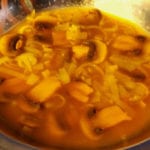 Movies and TV
Movies and TV  Movies and TV
Movies and TV  History
History 10 Things You Didn’t Know About the American National Anthem
 Technology
Technology Top 10 Everyday Tech Buzzwords That Hide a Darker Past
 Humans
Humans 10 Everyday Human Behaviors That Are Actually Survival Instincts
 Animals
Animals 10 Animals That Humiliated and Harmed Historical Leaders
 History
History 10 Most Influential Protests in Modern History
 Creepy
Creepy 10 More Representations of Death from Myth, Legend, and Folktale
 Technology
Technology 10 Scientific Breakthroughs of 2025 That’ll Change Everything
 Our World
Our World 10 Ways Icelandic Culture Makes Other Countries Look Boring
 Misconceptions
Misconceptions 10 Common Misconceptions About the Victorian Era
 Movies and TV
Movies and TV The 10 Coolest Stars to Set Sail on The Love Boat
 History
History 10 Things You Didn’t Know About the American National Anthem
 Technology
Technology Top 10 Everyday Tech Buzzwords That Hide a Darker Past
Who's Behind Listverse?

Jamie Frater
Head Editor
Jamie founded Listverse due to an insatiable desire to share fascinating, obscure, and bizarre facts. He has been a guest speaker on numerous national radio and television stations and is a five time published author.
More About Us Humans
Humans 10 Everyday Human Behaviors That Are Actually Survival Instincts
 Animals
Animals 10 Animals That Humiliated and Harmed Historical Leaders
 History
History 10 Most Influential Protests in Modern History
 Creepy
Creepy 10 More Representations of Death from Myth, Legend, and Folktale
 Technology
Technology 10 Scientific Breakthroughs of 2025 That’ll Change Everything
 Our World
Our World 10 Ways Icelandic Culture Makes Other Countries Look Boring
 Misconceptions
Misconceptions 10 Common Misconceptions About the Victorian Era
Top 10 National Dishes You Should Try
Most regular readers of Listverse will know that I am a food fanatic. It started as a child watching my family members baking on the weekends, and ultimately led me to try to teach myself French cuisine. Recently, I have been on a Korean food kick, and I can’t get enough of it. Because so many people on my Facebook profile have been seeing photos of my food exploits some suggested another food list. So this is the result. Here, I have tried to select a dish that is truly the main signature food of each country – in some cases when there are more than one, I have tried to choose one – but some may disagree. Please use the comments to mention your other favorite dishes from each nation here (or those not mentioned). Where possible I have included recipes.
Other significant dishes: Pampushki (potato dummplings), galushki (dumplings)
Most unusual dish: holodets (minced jellied pig’s feet)
Borscht is a soup, of Ukrainian origin, that is popular in many Eastern and Central European countries. In most of these countries, it is made with beetroot as the main ingredient, giving it a deep reddish-purple color. The soup began its existence from trimmings of cellared vegetables, consumed throughout the winter months. Most families had a container, usually a kettle or stove pot, kept outside to store those trimmings. Around the first spring thaw, that pot was placed on the fire and cooked into a soup-like meal. One of the primary vegetables of the Slavic diet consumed during the winter months was beets. Hence, the recipe morphed into what is traditionally known of as a beet soup. [Recipe]
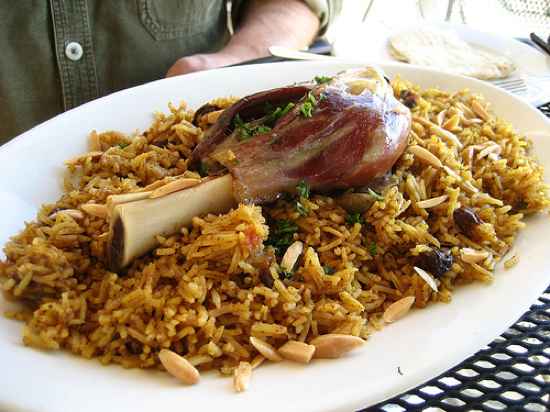
Other significant dishes: Mandi (rice and mutton), shawarma (kebab)
Most unusual dish: roast sheep’s eyes
Kabsa is an extremely tasty rice and meat dish from Saudi Arabia. There are many kinds of kabsa, and each kind has a uniqueness about it. The spices used in kabsa are largely responsible for its taste; these are generally black pepper, cloves, cardamom, saffron, cinnamon, black lime, bay leaves and nutmeg. The main ingredient that accompanies the spices is the meat, such as chicken, goat, lamb, camel or sometimes beef, fish and shrimp. In chicken machbūs, a whole chicken is used. The spices, rice and meat may be augmented with almonds, pine nuts, onions and raisins. A popular way of preparing the meat is called mandi. This is an ancient technique, whereby meat is barbecued in a deep hole in the ground, that is covered while the meat cooks. [Recipe]
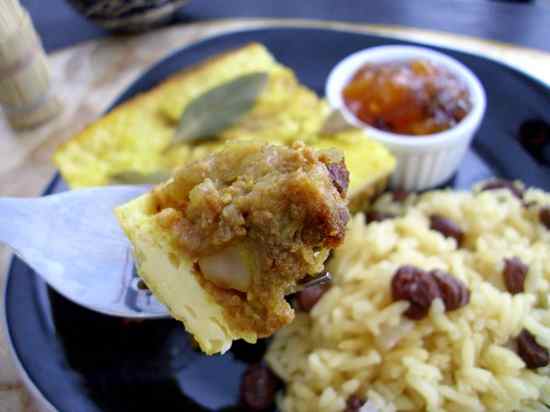
Other significant dishes: boerewors, biltong (jerked meat)
Most unusual dish: Mopane worm (caterpillar)
Bobotie is a South African dish consisting of spiced minced meat baked with an egg-based topping. Early recipes incorporated ginger, marjoram and lemon rind; the introduction of curry powder has simplified the recipe somewhat, but the basic concept remains the same. Some recipes also call for chopped onions to be added to the mixture. Traditionally, bobotie incorporates dried fruit like raisins or sultanas, but the sweetness that they lend is not to everybody’s taste. It is often garnished with walnuts, chutney and bananas. Although not particularly spicy, the dish incorporates a variety of flavors that can add complexity. For example, the dried fruit (usually apricots and raisins/sultanas) contrasts the curry flavoring very nicely. The texture of the dish is also complex, with the baked egg mixture topping complementing the milk-soaked bread which adds moisture to the dish. [Recipe]
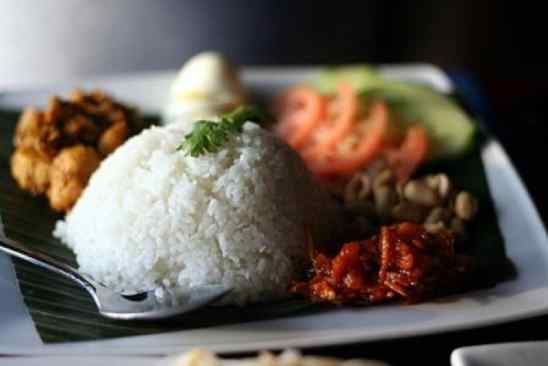
Other significant dishes: Roti canai (flatbread)
Most unusual dish: Pekasam Ikan (yeast coated fermented fish)
With roots in Malay culture, “nasi lemak” is a Malay word that literally means ‘fatty rice’. The name is derived from the cooking process whereby rice is soaked in coconut cream and then the mixture steamed. Sometimes knotted screwpine (pandan) leaves are thrown into the rice during steaming to give it more fragrance. Spices such as ginger and, occasionally, herbs like lemon grass may be added for additional fragrance. Traditionally, this comes as a platter of food wrapped in banana leaf, with cucumber slices, small dried anchovies, roasted peanuts, hard boiled egg and hot spicy sauce (sambal) at its core. As a more substantial meal, nasi lemak can also come with a variety of other accompaniments such as chicken, cuttlefish, cockle, stir fried water convolvulus, pickled vegetables, beef rendang (beef stewed in coconut milk and spices) or paru (beef lungs). [Recipe]
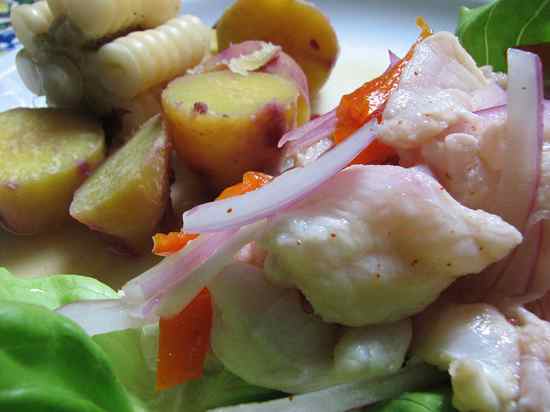
Other significant dishes: Papa a la Huancaina (yellow potato salad)
Most unusual dish: cuy (roast guinea pig)
Ceviche is relatively well known around the world. It is raw fish marinated in a citrus-based mixture, with lemons and limes being the most commonly used. In addition to adding flavor, the citric acid causes the proteins in the seafood to become denatured (effectively partly cooked). Traditional style ceviche was marinated for about 3 hours. Modern-style ceviche, created by Peruvian chef Dario Matsufuji in the 1970s, usually has a very short marinating period. With the appropriate fish, it can marinate in the time it takes to mix the ingredients, serve and carry the ceviche to the table. The classic Peruvian ceviche is composed of chunks of raw fish, marinated in freshly-squeezed key lime or bitter orange (naranja agria) juice, with sliced onions, chili, salt and pepper. Corvina or Cebo (sea bass) was the fish traditionally used. It is such an important dish in Peru that they have a national day for it. [Recipe]

Other significant dishes: kleftiko (lamb stew), fasolada (bean soup)
Most unusual dish: Patsa (feet and tripe soup)
Everyone loves lasagna – but if you haven’t tried moussaka you really are missing out on something quite extraordinary. Moussaka is the Greek equivalent of lasagna but it differs in a number of ways. Generally, it is made with veal or lamb (as opposed to beef), and instead of lasagna sheets it uses sliced eggplant (aubergine) or potato (in the Turkish version). The meat is flavored with cinnamon and pimento (allspice) and mixed with white wine. Like lasagna it is coated with a rich white sauce and it really is the most delicious Greek food. [Recipe]
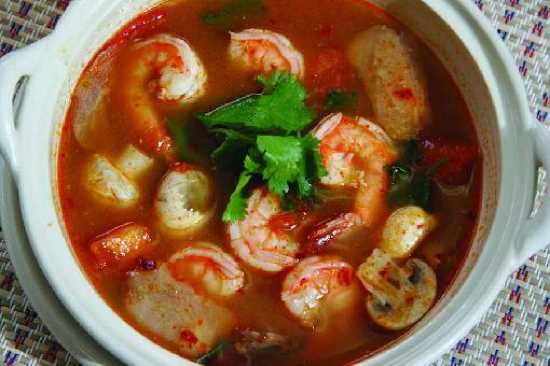
Other significant dishes: Pad Thai (Thai noodles)
Most unusual dish: Laab Luead (raw pork dressed with pig’s blood)
Tom yum soup is a hot, spicy and sour soup which usually includes prawns or chicken and mushrooms, cilantro (coriander), lemon grass, kaffir lime leaves and thai basil. It is a very fragrant soup (as is typical of much Thai food) and is very healthy – being very low in fat and carbohydrates. There are other varieties of tom yum, such as tom yum nam khon which includes coconut milk, but for the true delicious taste of Thailand you must try tom yum. Fortunately for most of us westerners it is possible to buy pre-made tom yum paste, which saves the many hours pounding all of the herbs together first. Of all the entries on this list (as well as the one above), tom yum soup is the one that most readers will have tried – but if you haven’t – do. Oh – and if you live in Wellington, New Zealand, the best Tom Yum soup in the city can be eaten here (as you can see by the rave reviews). [Recipe]
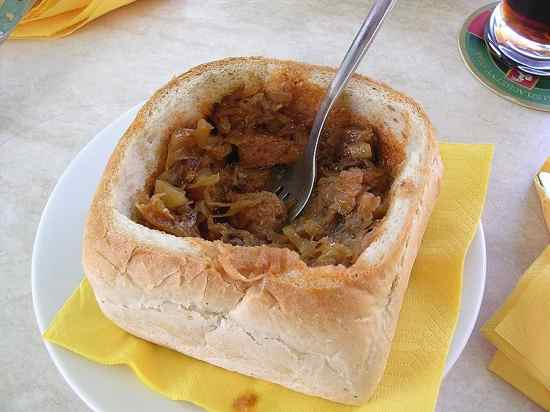
Other significant dishes: Golonka
Most unusual dish: Czernina (black duck’s blood soup)
Bigos (Hunter’s Stew), is a traditional meat stew typical of Polish, Lithuanian and Belarusian cuisines. There is no single recipe for a savory stew of cabbage and meat, as recipes vary considerably from region to region, as well as from family to family. Typical ingredients include white cabbage, sauerkraut (kapusta kiszona in Polish), various cuts of meat and sausages, often whole or puréed tomatoes, honey and mushrooms. The meats may include pork (often smoked), ham, bacon, beef, veal, sausage, and, as bigos is considered a real hunters’ stew, venison or other game; leftover cuts find their way into the pot as well.
Bigos is usually eaten with rye bread and potatoes. As with many stews, bigos can be kept in a cool place or refrigerated then reheated later—its taste actually intensifies when reheated. A common practice is to keep a pot of bigos going for a week or more, replenishing ingredients as necessary. [Recipe]
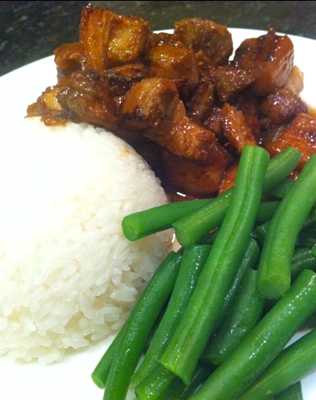
Other significant dishes: Lechon, Sinigang
Most unusual dish: Balut (duck embryo eggs)
Before colonization by the Spanish, the Philippines had their own unique method of cooking with vinegar, which preserved food and made it incredibly delicious. Pork adobo is almost certainly the national dish of the Philippines for that reason. Adobo was employed initially as a method of food preservation, but in time — with the advent of refrigeration methods — adobo became used primarily as a method of flavoring foods before cooking. Adobo typically involves cooking meat for a long period of time in a mixture of vinegar, garlic, salt and laurel leaves (bay leaves). The dish is either cooked until dry or cooked until a little of the cooking liquid remains as a sauce. The meat become very tender and the bite of the vinegar is removed whilst the flavor remains. It is a delicious dish that everyone should try. Pictured above is pork adobo I made with pork belly – it is served with rice and french beans. [Recipe]
Other significant dishes: Bulgogi – 불고기 (marinated beef – often called Korean Barbeque)
Most unusual dish: Bosintang – 보신탕 (dog stew)
I had to put Korean food (한식 – Hansik) first because it is my current passion – as you can see here. Also, it is quite unique in that much of the food is not prepared just for taste, but for health also – as has been the case for thousands of years. Much of Korean food is based on fermented products (naturally preserved) such as gochujang (hot pepper paste) and doenjang (soy bean paste – like Japanese miso). This gives it the easily recognizable red color. In addition to these pastes Korean food often includes hot pepper flakes – an essential ingredient in kimchi (which is pronounced gim-chee, NOT kim-chee, despite the spelling). Kimchi is fermented cabbage. There are many types of kimchi – cabbage kimchi (the most common), radish kimchi, water radish kimchi, etc.
Different recipes exist for each type, but one which I think is best for cabbage kimchi involves making a thick slurry with rice flour and water, and adding to it all of the seasoning: hot pepper flakes, scallions, Asian chives, raw oysters (or fermented squid), garlic, ginger, onions, pear and fish sauce. This is then spread on the individual leaves of the cabbage (which is kept whole). The cabbages are then kept in a container (traditionally outside in earthenware pots, but these days usually in glass or plastic in the fridge) where they ferment over time. Kimchi has a fresh taste and a crunchy texture and you can eat it immediately or when it is very well fermented (when it takes on a more sour flavor). For many Koreans, Kimchi is eaten with breakfast, lunch and dinner, and is such a staple part of the Korean diet that most Korean homes have a separate kimchi refrigerator. When Kimchi gets too sour to enjoy, you can use it as the basis for kimchi pancakes or kimchi stew. [Recipe]
Portions of this text is available under the Creative Commons Attribution-ShareAlike License; additional terms may apply. Some text is derived from or courtesy of Wikipedia.


